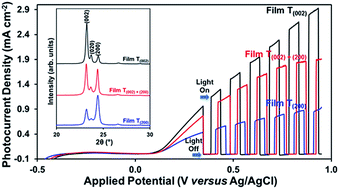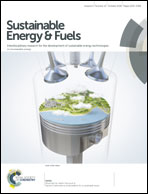Critical role of {002} preferred orientation on electronic band structure of electrodeposited monoclinic WO3 thin films†
Abstract
Monoclinic WO3 films with tunable (002) and (200) orientations parallel to fluorine-doped tin oxide substrates were electrodeposited from peroxotungstic acid (PTA) solutions and subjected to annealing (≤500 °C). It is concluded that the crystallographic orientations of the films are dependent on the nucleation density and the thermal-induced recrystallisation kinetics, which can be controlled respectively by the tungsten concentration of the PTA solution and the annealing conditions. This approach allows the fabrication of films with preferred (002), equally mixed (002) and (200), and (200) orientations, which were characterised in terms of the associated mineralogical, nanostructural, optical, chemical, photoelectrochemical, and photocatalytic properties. The present work decouples the concurrent effects of crystallographic orientation and trend in oxygen vacancy concentration on the optical indirect band gap of WO3 thin films, where the linear correlation between these three variables can be used as a diagnostic tool to engineer the electronic band structure of films for applications requiring photosensitivities in different regions of the solar spectrum. In effect, a low valence band maximum, low oxygen vacancy concentration, and resultant low band gap associated with (002) preferred orientation results in the highest photoelectrochemical performance, which is relevant to applications under solar illumination. In contrast, a high concentration of oxygen vacancies, which act as surface reaction sites associated with (200) preferred orientation, results in the highest efficiency in the photodegradation of methylene blue, which is relevant to applications under UV illumination.

- This article is part of the themed collection: Artificial Photosynthesis - From Sunlight to Fuels and Valuable Products for a Sustainable Future


 Please wait while we load your content...
Please wait while we load your content...